Regardless of the type of valve, ensuring that you purchase the right size and dimension is necessary to guarantee flow efficiency in your application. The size affects the amount of pressure the valve can support, which may affect the flow rate and control in turn. Finding the right size can save you costs and earn you good returns on investment.
Valve Sizing
A general practice to determine the correct valve size is to use the equation Q = Cv√(ΔP/G), where Q is the capacity in gallons per minute, Cv is the valve flow coefficient, ΔP is the pressure differential in pound per square inch, and G is the specific gravity of the fluid.
Manufacturers typically have a list of valve flow coefficients for all the models and dimensions of their industrial valves. By finding the Cv required for your application, you can choose a suitable valve size.
Valve Codes and Standards
DIN valve standards
DIN valve standards, set by the Deutsches Institut für Normung, are more commonly known as German valve standards. Common standards include DIN EN 488, DIN EN, and more, varying depending on the application type.
BS valve standards
BS valve standards are set by the British Standards Institution, the national standards authority of the United Kingdom. Types include BS 1212 for ball valves, BS 1414 for gate valves, and others.
ISO valve standards
ISO valve standards, published by the International Organization for Standardization, define the qualifications required for designs, functionality, and other aspects of industrial valves.
ASME valve standards
ASME valve standards are set and regulated by the American Society of Mechanical Engineers. These standards may detail the pressure and temperature ratings of certified industrial valves.
Ball Valve Size Dimension Chart
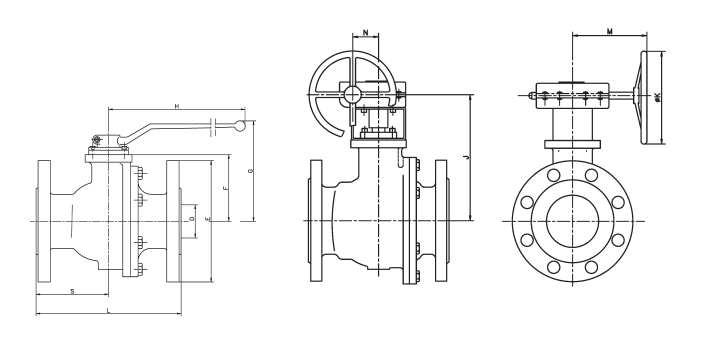
Image Source: Pekos
| Size (Class 150) | D | L | E | F | G | H | S |
| 1-inch ball valve dimensions | 25 | 127 | 108 | 60 | 113 | 185 | 56 |
| 2-inch ball valve dimensions | 50 | 178 | 152 | 84 | 153 | 300 | 92 |
| 3-inch ball valve dimensions | 80 | 203 | 191 | 114 | 205 | 355 | 101 |
| 4-inch ball valve dimensions | 100 | 229 | 229 | 128 | 220 | 355 | 114 |
| 6-inch ball valve dimensions | 150 | 394 | 279 | 175 | 284 | 680 | 165 |
| 8-inch ball valve dimensions | 200 | 457 | 343 | 245 | 362 | 750 | 228 |
| 10-inch ball valve dimensions | 250 | 533 | 406 | 285 |
What is a standard ball valve size? Depending on the valve class you select, the ball valve standard dimensions will vary. For example, valve diameters may go from 15 to 600 millimeters (mm) for those categorized under Class 150.
If you’re asking the question “How do I know what ball valve size I need?”, referring to the size of your hose or pipe is one way to do it. For instance, a two-inch ball valve may be suitable for a two-inch hose. But this may not be true for reduced bore ball valve dimensions.
On how to measure ball valve sizes, you should consider measuring their diameters. Usually, markings like DNXX can be found on the valves. DN stands for nominal diameter, followed by the valve’s diameter size in mm.
Butterfly Valve Size/Dimension Chart
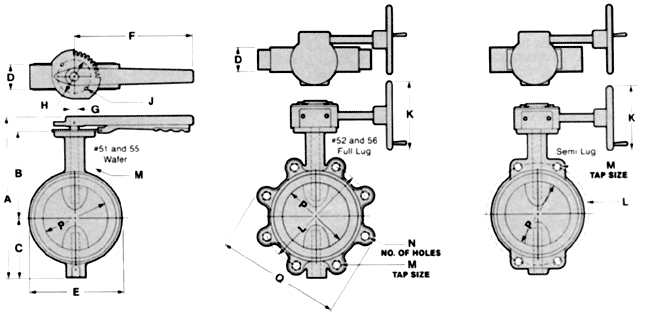
Image Source: Robert-JamesSales, Inc.
| Size | A | B | C | D | E | F | G | H | J | K | L | M | N | P | Q | R |
| 3-inch butterfly valve dimensions | 10-11/16 | 6 | 3-11/16 | 1-7/8 | 5-7/8 | 8 | 0.561 | 3-1/4 | 9/32 | 6 | 6 | 5/8-11 | 4 | 3 | 7-1/2 | 3 |
| 4-inch butterfly valve dimensions | 13 | 7 | 4-13/16 | 2-1/8 | 6-15/16 | 11 | 0.686 | 3-1/4 | 9/32 | 6 | 7-1/2 | 5/8-11 | 8 | 4 | 9-1/8 | 3 |
| 6-inch butterfly valve dimensions | 15-3/16 | 7-15/16 | 5-7/8 | 2-1/4 | 8-3/4 | 11 | 0.811 | 3-1/4 | 9/32 | 6 | 9-1/2 | 3/4-10 | 8 | 6 | 11-1/4 | 3 |
| 8-inch butterfly valve dimensions | 17-3/4 | 9-3/16 | 6-15/16 | 2-1/2 | 11 | 16 | 0.936 | 4-3/4 | 17/32 | 10 | 11-3/4 | 3/4-10 | 8 | 8 | 13-3/4 | 3 |
| 10-inch butterfly valve dimensions | 20-1/2 | 10-1/2 | 8-3/8 | 2-13/16 | 13-3/8 | 16 | 1.123 | 4-3/4 | 17/32 | 10 | 14-1/4 | 7/8-9 | 12 | 10 | 16 | 3 |
| 12-inch butterfly valve dimensions | 23-1/2 | 12-1/6 | 9-13/16 | 3-1/8 | 16 | 16 | 1.247 | 4-3/4 | 17/32 | 10 | 17 | 7/8-9 | 12 | 12 | 19 | 3 |
| 24-inch butterfly valve dimensions | 40-3/16 | 19 | 17-7/16 | 6-1/8 | 28-1/4 | 3 | 7-1/2 | 24 | 29-1/2 | 1-1/4-7 | 20 | 23-1/4 | 32 |
What is the nominal size of butterfly valves? The most common size configurations available on the market go from 2 to 36 or 60 inches. DN100 butterfly valve dimensions are some of the most common, as well as lug-type butterfly valve bolt lengths.
Gate Valve Size & Dimension Chart
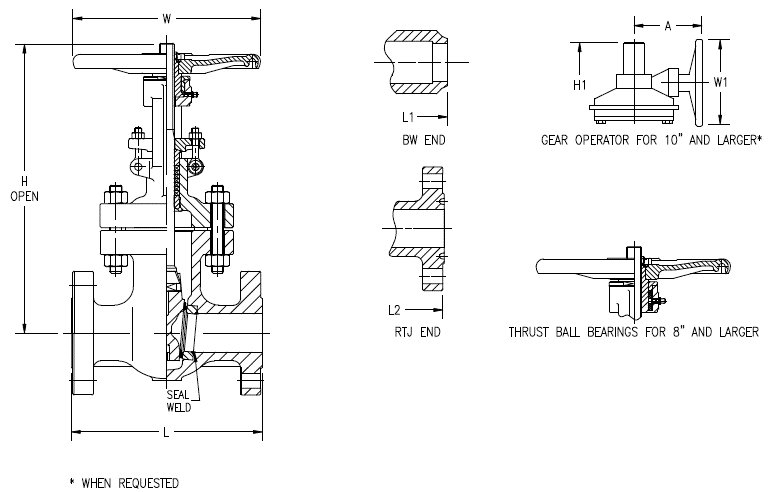
Image Source: Bonney Forge
| Size (in mm) | L | L2 | W | W1 | H | H1 | A |
| 2-inch gate valve dimensions | 215.9 | 231.65 | 200 | 430 | |||
| 3-inch gate valve dimensions | 282.45 | 298.45 | 250 | 555 | |||
| 4-inch gate valve dimensions | 304.8 | 320.55 | 250 | 620 | |||
| 6-inch gate valve dimensions | 403.35 | 419.1 | 350 | 305 | 805 | 835 | 220 |
| 8-inch gate valve dimensions | 419.1 | 434.85 | 400 | 305 | 1005 | 1035 | 220 |
| 12-inch gate valve dimensions | 501.65 | 517.4 | 500 | 460 | 1465 | 1479 | 267 |
| 24-inch gate valve dimensions | 1143 | 1165.35 | 900 | 610 | 2837 | 2667 | 411 |
Measuring a gate valve involves knowing its hole-to-hole dimensions, stem height, valve travel, and other measures. By gathering this data, you can accurately select the correct gate valve for your application.
Globe Valve Size Dimension Chart

Image Source: Rache Process
| Size (in mm) | L | H | W |
| 2-inch globe valve | 203 | 340 | 225 |
| 3-inch globe valve | 241 | 419 | 302 |
| 4-inch globe valve | 292 | 441 | 325 |
| 6-inch globe valve | 406 | 610 | 451 |
| 8-inch globe valve | 495 | 679 | 549 |
When picking a globe valve, knowing its Cv rating, or its flow coefficient, would be of help. This is the amount of water in gallons per minute that flows through a valve at 20° C and 1 PSI. If you don’t know what a globe valve looks like, a good indicator would be its slightly spherical shape.
Foot Valve Size Dimension Chart
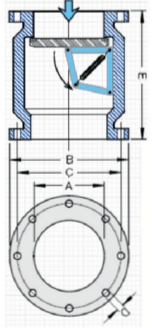
Image Source: Irrigation Direct
| Size (in mm) | A | B | C | D | E |
| 3-inch foot valve | 76 | 185 (260) | 146 | 18 | 250 (230) |
| 4-inch foot valve | 101 | 215 (260) | 178 | 18 | 280 (280) |
| 6-inch foot valve | 152 | 280 (330) | 235 | 18 | 360 (340) |
| 8-inch foot valve | 203 | 335 (385) | 292 | 18 | 400 (390) |
| 10-inch foot valve | 254 | 405 (530) | 356 | 22 | 440 (590) |
What size foot valve do I need? The rule of thumb in the industry is to select a valve one size bigger than that of the pump discharge pipe. For example, a suitable foot valve for a 4-inch pipe would be a 6-inch foot valve.
Float Valve Size Dimension Chart
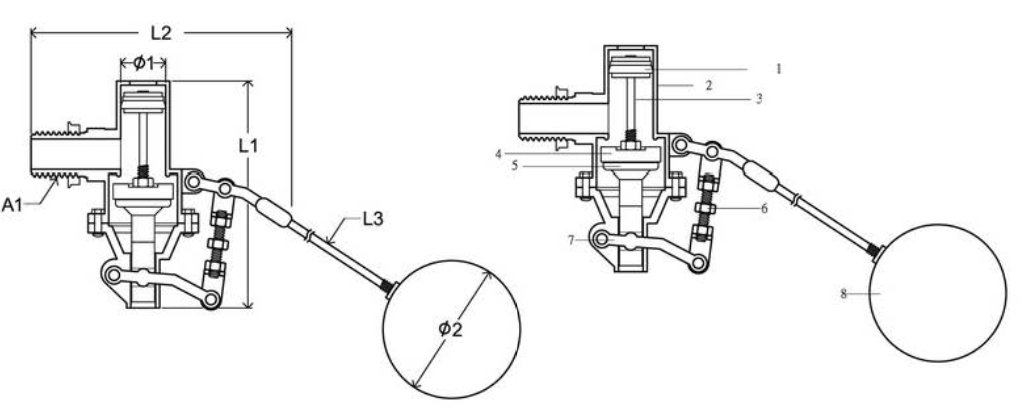
Image Source: Z-Tide Valve
| Float valve size | Float thread size | Float ball size | Float ball thread size |
| 1-inch float valve | 1 1/4 inches | 8 inches | 7/16 |
| 2-inch float valve | 2 1/4 inches | 12 inches | 5/8 |
When selecting a float ball size, it’s important to know the speed of draining and filling of your tank. The rule of thumb is that the faster the rate is, the larger the float ball that you would need to purchase.
Solenoid Valve Size Dimension Chart
–
Image Source:
Alt-text:
No date found for solenoid valve.
Selecting a solenoid valve is highly dependent on the flow factor, known in the industry as Kv, which details the amount of water passing through the solenoid valve in 60 seconds at room temperature and 1 bar.
Check Valve Size Dimension Chart

Image Source: Process Systems
| Size (in mm) | D | C | G | T | L | H | N-M |
| 4-inch check valve dimensions | 229 | 190.5 | 157 | 23.9 | 292 | 196 | 8-19 |
| 5-inch check valve | 254 | 216 | 186 | 23.9 | 330 | 202 | 8-22 |
Check valves do come in varying configurations, so selecting one that fits your application matters. But what size check valve do I need? To measure the ideal one with the check valve sizing calculation, you must know the floor velocity needed to lift its disc. After this, determine the average flow velocity in your pipes, ensuring that it’s either higher or equivalent to the minimum velocity of the valve.
